Dime Novel from Wikipedia
| Dime novel, though it has a specific meaning, has also
become a catch-all term for several different (but related) forms of late
19th-century and early 20th-century U.S. popular fiction, including “true”
dime novels, story papers, five- and ten-cent weekly libraries, “thick
book” reprints, and sometimes even early pulp magazines. The term was being
used as late as 1940, in the short-lived pulp Western Dime Novels. Dime
novels are, at least in spirit, the antecedent of today's mass market paperbacks,
comic books, and even television shows and movies based on the dime novel
genres. In the modern age, "dime novel" has become a term to describe any
quickly written, lurid potboiler and as such is generally used as a pejorative
to describe a sensationalized yet superficial piece of written work...
History
Origin of term
It is generally agreed that the term originated with the
first book in Beadle & Adam's Beadle's Dime Novel series, Maleaska,
the Indian Wife of the White Hunter, by Ann S. Stephens, dated June 9,
1860. The novel was essentially a reprint of Stephens's earlier serial
that appeared in the Ladies' Companion magazine in February, March, and
April 1839. The dime novels varied in size, even within this first Beadle
series, but were roughly 6.5 by 4.25 inches (17 by 10.8 cm), with 100 pages.
The first 28 were published without a cover illustration, in a salmon colored
paper wrapper, but a woodblock print was added with issue 29, and reprints
of the first 28 had an illustration added to the cover. Of course, the
books were priced at ten cents.
This series ran for 321 issues, and established almost
all the conventions of the genre, from the lurid and outlandish story to
the melodramatic double titling that was used right up to the very end
in the 1920s. Most of the stories were frontier tales reprinted from the
vast backlog of serials in the story papers and other sources,] as well
as many originals. |
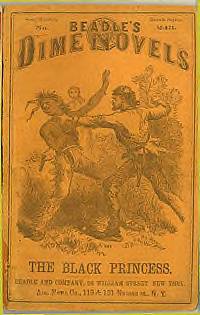
An example of the original dime novel
series, circa 1860. |
As the popularity of dime novels increased, original stories
came to be the norm. The books were themselves reprinted many times, sometimes
with different covers, and the stories were often further reprinted in
different series, and by different publishers.
Beadle's Dime Novels were immediately popular among young,
working-class audiences, owing to an increased literacy rate around the
time of the American Civil War. By the war's end, there were numerous competitors
like George Munro and Robert DeWitt crowding the field, distinguishing
their product only by title and the color choice of the paper wrappers.
Even Beadle & Adams had their own alternate "brands", such as the Frank
Starr line. As a whole, the quality of the fiction was derided by higher
brow critics and the term 'dime novel' quickly came to represent any form
of cheap, sensational fiction, rather than the specific format.
Prices
Adding to the general confusion as to what is or is not
a dime novel, many of the series, though similar in design and subject
matter, cost ten to fifteen cents. Even Beadle & Adams complicated
the issue with a confusing array of titles in the same salmon colored covers
at different price points. Also, there were a number of ten-cent, paper
covered books of the period that featured medieval romance stories and
soap opera-ish tales. This made it hard to define what falls within the
definition of a true dime novel, with the division depending on format,
price, or style of material for the classification. Examples of Dime Novel
series that showcase the diversity of the term include: Bunce's Ten Cent
Novels, Brady's Mercury Stories, Beadle's Dime Novels, Irwin P. Beadle's
Ten Cent Stories, Munro's Ten Cent Novels, Dawley's Ten Penny Novels, Fireside
Series, Chaney's Union Novels, DeWitt's Ten Cent Romances, Champion Novels,
Frank Starr's American Novels, Ten Cent Novelettes, Richmond's Sensation
Novels, Ten Cent Irish Novels, etc.
| In 1874, Beadle & Adams by added the novelty of color
to the covers when their New Dime Novels series replaced the flagship title.
The New Dime Novels were issued with a dual numbering system on the cover,
one continuing the numbering from the first series, and the second and
more prominent one indicating the number within the current series, i.e.,
the first issue was numbered 1 (322). The stories were largely reprints
from the first series. Like its predecessor, Beadle's New Dime Novels ran
for 321 issues, until 1885.
Development of the dime novel
As noted, much of the material for the dime novels came
from the storypapers, which were weekly, eight page newspaper-like publications,
varying in size from tabloid to a full fledged newspaper format, and usually
costing five or six cents. They started in the mid 1850s and were immensely
popular, some titles running for over fifty years on a weekly schedule.
They are perhaps best described as the television of their day, containing
a variety of serial stories and articles, with something aimed at each
members of the family, and often illustrated profusely with woodcut illustrations.
Popular storypapers included The Saturday Journal, Young Men of America,
Golden Weekly, Golden Hours, Good News, Happy Days.
Although the larger part of the stories stood alone, in
the late 1880s series characters began to appear and quickly grew in popularity.
The original Frank Reade stories first appeared in Boys of New York. Old
Sleuth, appearing in The Fireside Companion story paper beginning in 1872,
was the first dime novel detective and began the trend away from the western
and frontier stories that dominated the story papers and dime novels up
to that time. He was the first character to use the word “sleuth” to denote
a detective, the word's original definition being that of a bloodhound
trained to track. And he also is responsible for the popularity of the
use of the word “old” in the names of competing dime novel detectives,
such as Old Cap Collier,
|
..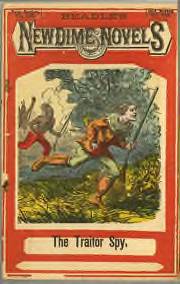
The New Dime Novel Series
introduced color covers, but
reprinted stories from the original
series. |
Old Broadbrim, Old King Brady, Old Lightning, Old Ferret
and many, many others. Nick Carter first appeared in 1886 in The New York
Weekly. All three characters would graduate to their own ten-cent weekly
titles within a few years.
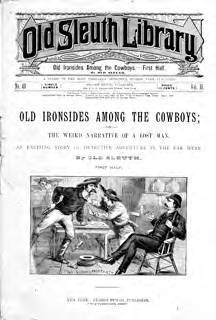
Old Sleuth Library, 1888 |
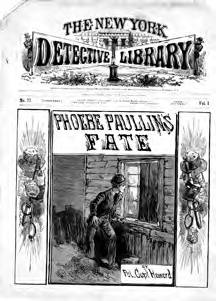
Frank Tousey's major black and white library, 1884 |
Changing formats
In 1873, the house of Beadle & Adams had introduced
a new ten-cent format, 9 by 13.25 inches (230 × 337 mm), with only
32 pages and a black and white illustrated cover, with the title New and
Old Friends. It was not a success, but the format was so much cheaper to
produce that they tried again in 1877 with The Fireside Library and Frank
Starr's New York Library. The first reprinted English love stories, the
second contained hardier material but both titles caught on. Publishers
were no less eager to follow a new trend then than now. Soon the newsstands
were flooded by ten-cent weekly “libraries”. These publications also varied
in size, from as small as 7 x 10 inches (The Boy's Star Library is an example)
to 8.5 x 12 (New York Detective Library). The Old Cap Collier Library was
issued in both sizes, plus a booklet form. Each issue tended to feature
a single story, as opposed to the story papers, and many of them were devoted
to single characters. Frontier stories, evolving into westerns, were still
popular, but the new vogue tended to urban crime stories. One of the most
successful titles, Frank Tousey's New York Detective Library eventually
came to alternate stories of the James Gang with stories of Old King Brady,
detective, and in a rare occurrence in the dime novel world, there were
several stories which featured them both, with Old King Brady doggedly
on the trail of the vicious gang.
The competition was fierce, and publishers were always
looking for an edge. Once again, color came into the fray when Frank Tousey
introduced a weekly with brightly color covers in 1896. Street & Smith
countered by issuing a smaller format weekly with muted colors Such titles
as New Nick Carter Weekly (continuing the original black and white Nick
Carter Library), Tip-Top Weekly (introducing Frank Merriwell) and others
were 7 x 10 with thirty-two pages of story, but the 8.5 x 11 Tousey format
carried the day and Street & Smith, soon followed suit. The price was
also dropped to five cents, making the magazines more accessible to children.
This would be the last major permutation of the product before it evolved
into pulp magazines. Ironically, for many years it has been the nickel
weeklies that most people refer to when using the term "dime novel."
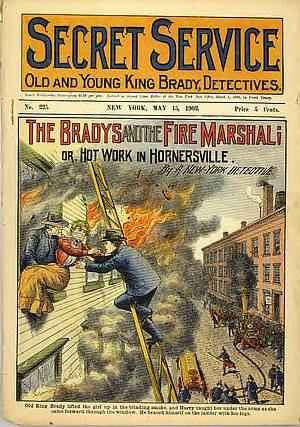 .. ..
One of the most popular color covered nickel weeklies,
Secret Service, no. 225, May 15, 1903.
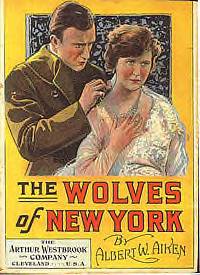
An example of the "thick book" series,
American Detective Series no. 21,
from the Arthur Westbrook Co..
|
The nickel weeklies proved very popular, and their numbers
grew quickly. Frank Tousey and Street & Smith dominated the field.
Tousey had his “big six” : Work and Win (featuring Fred Fearnot, a serious
rival to the soon to be popular Frank Merriwell) Secret Service, Pluck
and Luck, Wild West Weekly, Fame and Fortune, and The Liberty Boys of ’76,
all of which ran over a thousand weekly issues apiece. 7] Street &
Smith had New Nick Carter Weekly, Tip Top Weekly, Buffalo Bill Stories,
Jesse James Stories, Brave & Bold Weekly and many others. The Tousey
stories were on the whole the more lurid and sensational of the two.
Perhaps the most confusing of all the various formats
that are lumped together under the term dime novel are the so-called “thick-book”
series, largely published by Street & Smith, J. S. Ogilvie and Arthur
Westbrook. These books were published in series, ran roughly 150-200 pages,
and were 4.75 by 7 inches (121 × 180 mm), often with color covers
on a higher grade stock. They reprinted multiple stories from the five-
and ten-cent weeklies, often slightly rewritten to tie the material together.
All dime novel publishers were canny about repurposing
material. but Street & Smith made it more of an art form. They developed
the practice of publishing four consecutive, related tales of, for example,
Nick Carter, in the weekly magazine, then combining the four stories into
one edition of the related thick book series, in this instance, the New
Magnet Library. The Frank Merriwell stories appeared in the Medal, New
Medal and Merriwell Libraries, Buffalo Bill in the Buffalo Bill Library
and Far West Library, and so on. What confuses many dealers and new collectors
today is that though the thick books were still in print as late as the
1930s, they carry the original copyright date of the story, often as early
as the late nineteenth century, leading some to assume they have original
dime novels when the books are only distantly related.
End of the dime novel
In 1896, Frank Munsey had converted his juvenile magazine,
The Argosy into a fiction magazine for adults and the first pulp. By the
turn of the century, new high-speed printing techniques combined with the
cheaper pulp paper allowed him to drop the price from twenty five cents
to ten cents, and the magazine really took off. In 1910 Street and Smith
converted two of their nickel weeklies, New Tip Top Weekly and Top Notch
Magazine, into pulps; in 1915, Nick Carter Stories, itself a replacement
for the New Nick Carter Weekly, morphed into Detective Story Magazine,
and in 1919, New Buffalo Bill Weekly became Western Story Magazine. Harry
Wolff, the successor in interest to the Frank Tousey titles, continued
to reprint many of them up into the mid 1920s, most notably Secret Service,
Pluck and Luck, Fame and Fortune, and Wild West Weekly. The latter two
were purchased by Street & Smith in 1926 and converted into pulp magazines
the following year. That effectively ended the reign of the dime novel.
Collections
In the late 1940s to the early 1950s, collecting dime
novels became very popular, and prices soared. Albert Johannsen authored
an enormous two volume scholarly work, The House of Beadle & Adams,
which is exhaustive in its detail. Even at that time the cheap publications
were crumbling into dust and becoming hard to find. William J. Benners
was another of the early historians of the dime novel. He was also a publisher
and author. Edward T. LeBlanc, a longtime editor of the periodical Dime |
Novel Round-Up, was also an avid collector and bibliographer
of the format. T wo of the prominent collectors, Charles Bragin and Ralph
Cummings, issued a number of reprints of particularly hard to find titles
from some of the weekly libraries. But most of the collectors were men
who remembered the stories from childhood, and as they passed on, the craze
subsided and dime novels, of all varieties, lost their appeal and are only
marginally collected today. |
| Ned Buntline from Wikipedia
Ned Buntline (March 20, c. 1813 – July 16, 1886), was
a pseudonym of Edward Zane Carroll Judson (E. Z. C. Judson), an American
publisher, journalist, writer and publicist best known for his dime novels
and the Colt Buntline Special he is alleged to have commissioned from Colt's
Manufacturing Company.
Naval and military experience
Edward Judson was born in Stamford, Delaware County, New
York. As a boy, Ned ran away to sea as a cabin-boy, and the next year shipped
on board of a man-of-war. When he was thirteen years old, he rescued the
crew of a boat that had been run down by a Fulton ferry boat, and received
a commission as midshipman in the U.S. Navy from President Van Buren. On
being assigned to the “Levant,” he challenged 13 midshipmen to duels who
refused to mess with him because he had been a common sailor, and fought
the seven who accepted, wounding four, while escaping without a wound himself.
"Buntline" is a nautical term for a rope at the bottom
of a square sail. As a seaman, he fought in the Seminole Wars, though he
saw little combat. After four years at sea, he resigned. During the Civil
War, he served as an enlisted man in the 1st New York Mounted Rifles, although
he later claimed to have been chief of scouts among the Indians, with the
rank of colonel, and to have received twenty wounds.
Early literary efforts
His first literary efforts began with a story of adventure
in the Knickerbocker in 1838. Buntline spent several years in the east
starting up newspapers and story papers, only to have most of them fail.
An early success that helped launch his fame was a gritty serial story
of the Bowery and slums of New York City titled The Mysteries and Miseries
of New York. An opinionated man, he strongly advocated nativism and temperance.
Involvement in riots
He became editor of a weekly story paper, called Ned Buntline's
Own, in 1848. Through his writing in its columns and his association with
New York City's notorious gangs of the early 19th century, he was one of
the instigators of the Astor Place Riot which left 23 people dead. In September
1849, he was sentenced to a $250 fine and a year's imprisonment. After
his release he devoted himself to writing sensational stories for weekly
newspapers, and his income from this source is said to have amounted to
$20,000 a year. He was also involved in a nativist riot in St. Louis, which
would later come back to haunt him. |
..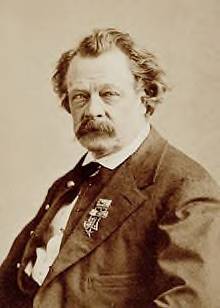 . .
Ned Buntline
.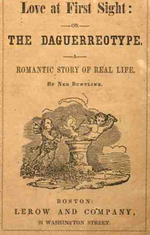
Love at First Sight: or the Daguerreotype,
a Romantic Story of Real Life by Ned Buntline
(Lerow & Co., Washington St., Boston, ca.1847) |
..........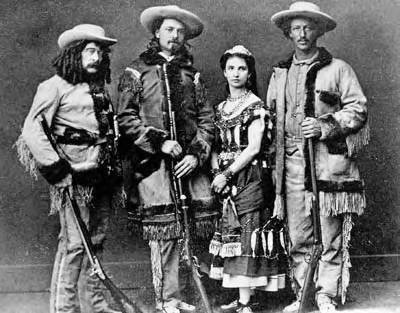
......Ned Buntline, Bufalo
Bill Cody, Giuseppina Morlacchi, Texas Jack Omohundro, 19th c.
Temperance and politics
Although a heavy drinker, he traveled around the country
giving lectures about temperance, and until the presidential canvass of
1884 was an ardent Republican politician. It was on one of his temperance
lecture tours that he encountered Buffalo Bill.
Wild Bill Hickok
While traveling through Nebraska, Buntline heard that
Wild Bill Hickok was in Fort McPherson. Having read a popular article about
the Wild West figure, Buntline hoped to interview Hickok with the desire
to write a dime novel about him. Finding Hickok in a saloon, he rushed
up to him saying "There's my man! I want you!". By this time in his life,
Hickok had an aversion to surprises. He threatened Buntline with a gun
and ordered him out of town in twenty-four hours. Buntline took him at
his word and left the saloon. Still looking to get information on his subject,
Buntline took to finding Hickock's friends. It is likely that this is how
he first met "Buffalo Bill," whose real name was William Cody.
Buffalo Bill
Traveling with Cody on an Indian scout, Buntline became
enamored with the gregarious man. He gave up his desire to write a novel
about Hickok and he decided to write one on Cody instead. Cody at first
was a reluctant hero. Buntline's dime novel series: Buffalo Bill Cody -
King of the Border Men was a fantastic success. Buntline immediately began
cajoling Cody to come east and take part in a stage play. Cody at first
resisted, but after an eastern trip financed by wealthy newspapermen, decided
he enjoyed the spotlight after all. Buntline wrote a play titled Scouts
of the Prairie, which opened in Chicago in December 1872 and starred Cody
and Texas Jack Omohundro. Although panned by critics, the play was a great
success, and it was performed to packed theaters across the country.
While successful, Cody found he could not keep the money
he made, nor stand the eccentricities of Buntline. At the height of its
popularity, the show closed in June 1873, and Cody and Buntline went their
separate ways.
Later work
Buntline continued to write dime novels, though none was
as successful as his earlier work. He settled into his home in Stamford,
New York, where he died of congestive heart failure in 1886. Although he
was once one of the wealthiest authors in America, his wife had to sell
his beloved home "The Eagle's Nest" to pay the bills.
. |
Giuseppina Morlacchi from Wikipedia
.
| Giuseppina Morlacchi (1846 - July 25, 1886) was an Italian
American ballerina and dancer, who introduced the can-can to the American
stage, and married the scout and actor Texas Jack Omohundro. She was born
in Milan, and attended dance school at La Scala. She debuted on the stage
in 1856 at Genoa. In short time she became a well-known dancer, touring
the continent and England. In Lisbon, she met noted artist and manager
John DePol, who persuaded her to go to America.
In October 1867, she made her American debut at Banvard's
Museum in New York City, performing The Devil's Auction. She became an
immense success, and DePol took the show to Boston. During her rise to
fame DePol insured her legs for $100,000 after which newspapers claimed
Moriacchi was 'more valuable than Kentucky'.
From 1867 though 1872 Giuseppina traveled the United States
dancing in various venues with Morlacchi Ballet Troupe which she formed
performing before various politicians, dignitaries and the Grand Duke of
Russia. On January 6, 1868, the company played at the Theatre Comique and
premiered a new type of dance, billed as "...Grand Gallop Can-Can, composed
and danced by Mlles. Morlacchi, Blasina, Diani, Ricci, Baretta,... accompanied
with cymbals and triangles by the coryphees and corps de ballet." The new
dance received an enthusiastic reception.
From then, her fame and success increased, and she played
a succession of popular performances. On December 16, 1872, she was billed
as a feature attraction in Ned Buntline's western drama, Scouts of the
Prairie, with Buffalo Bill Cody and Texas Jack Omohundro. She and Texas
Jack fell in love, and were married on August 31, 1873. The couple settled
in a country estate in Lowell, Massachusetts and an additional home Leadville,
Colorado, though she continued to perform, both with her husband in western
dramas, and solo.
Following the death of her husband in 1880 in Leadville,
she returned to Lowell and lived quietly with her sister. She died of cancer
in 1886, and is buried in Lowell. |
..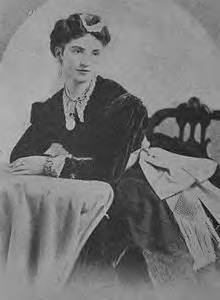 . . |
|
All articles submitted to the "Brimstone
Gazette" are the property of the author, used with their expressed permission.
The Brimstone Pistoleros are not
responsible for any accidents which may occur from use of loading
data, firearms information, or recommendations published on the Brimstone
Pistoleros web site. |
|